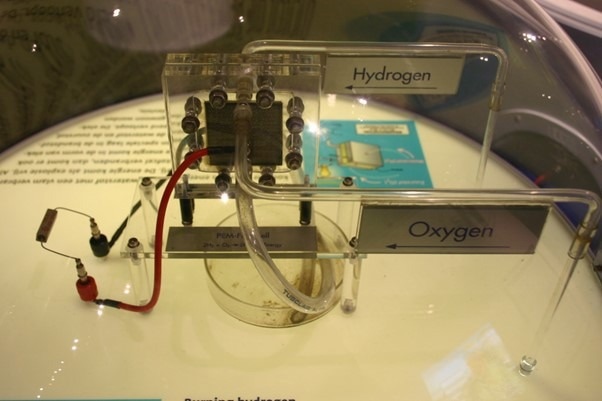Hydrogen fuel cells are an efficient alternative to fossil fuels since they only release water while producing energy. Their key component is the polymeric membrane serving as an electrolyte as well as a separator. Now, scientists from South Korea have developed a new anion exchange membrane by crosslinking two polymers with different properties (one for rigidity and the other for elasticity). This caused an improved morphology, conductivity, stability, and overall performance of the AEMFCs.

Image Credit: Incheon National University
Fossil fuels are major contributors to pollution, leading to global warming and erratic climatic fluctuations. Hydrogen fuel cells are a promising eco-friendly alternative to fossil fuels, since they use hydrogen as a source to produce electricity, releasing only water and heat in the process.
Several types of hydrogen fuel cells exist, among which anion exchange membrane alkaline fuel cells (AEMFCs) are quite popular. These employ anion exchange membranes (AEMs), which require excellent chemical stability to perform efficiently under alkaline conditions. Poly(aryl piperidinium) (PAP) is a potential candidate for the preparation of these membranes. However, early prototypes created purely from this polymer have sub-par mechanical strength and phase separation, necessitating further modifications.
To this end, Professor Tae-Hyun Kim and colleagues at the Incheon National University, South Korea, have developed a new AEM by crosslinking poly(bibenzyl N-methyl piperidine) (PBB)—a rigid PAP unit—with poly(styrene-b-ethylene-co-butylene-b-styrene) (SEBS)—an elastic component. They also evaluated the new AEM’s (x-PBB-SEBS) physical, chemical, and electrical properties under laboratory and real time fuel cell conditions.
Discussing the motivation behind the study, which was published online on October 13, 2022 in volume 664 of Journal of Membrane Science, Prof. Kim remarks, “This research was conducted primarily to improve the performance and durability of anion exchange membrane alkaline fuel cells through the development of electrolyte membranes, the key components of fuel cells.”
The research team developed three types of membranes with varying degrees of crosslinking (30%, 40%, and 50%) by modifying the ratio of PBB to SEBS. All three exhibited high mechanical and tensile strength, excellent phase separation, and ionic conductivity.
Furthermore, the membrane with the 40% crosslinking (40x-PBB-SEBS) proved to be the most optimal with respect to its balance between toughness and elasticity.
It also demonstrated a very high ionic conductivity of 72.28–146.25 mS cm-1, and outstanding alkaline and oxidative stability, due to its increased crosslinking.
Moreover, as AEMs function as electrolytes, they require high water retention for a satisfactory performance. On testing the membranes in an AEM fuel cell, the team found that 40x-PBB-SEBS recorded the highest relative humidity, normalized conductivity, and an impressive peak power density. The membrane even surpassed the performance of a commercially used membrane by a huge margin, when tested in real time using AEM water electrolysis!
These findings have laid a strong foundation for the development of additional high-performance materials for AEMs with superior performances. Sharing his vision for the future, Prof. Kim muses, “The capabilities of the bibenzyl-SEBS crosslinked membrane exhibits can enable their introduction into hydrogen mobility and home power generation systems as well as in eco-friendly hydrogen production facilities. In this manner, our research can contribute to eco-friendly energy production and carbon neutrality.”